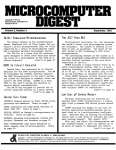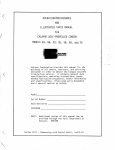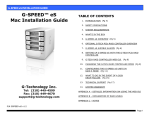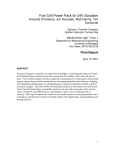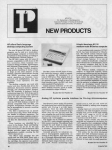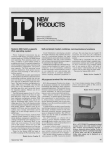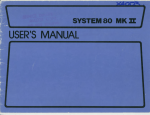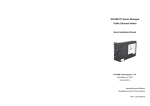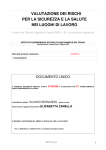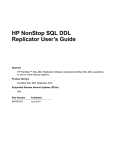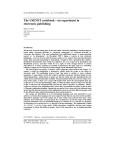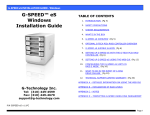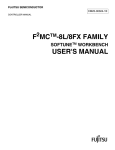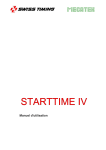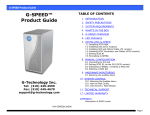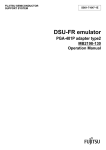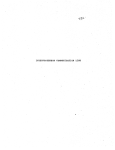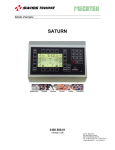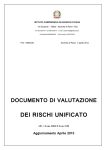Download NEW PRODUCTS
Transcript
edited by Demetrios A. Michalopoulos Associate Professor of Computer Sciences California State University at Fullerton NEW PRODUCTS New Intersil floppy disk system, shown here with Intercept prototyping system (top). Intersil introduces floppy-disk development system Micro Control has announced a CRT terminal-operated memory and LSI test system for production and engineering environments. The M-IOAT features 1 nsec timing resolution with a range of 0-65 usec; 10 MHz operation; 16 data bits, expandable to 72 bits; 16 address bits, expandable to 24, with optional topological scrambler available; automatic operation controlled by an 8-bit 8080 microprocessor; and tape cartridge storage of test programs. Software is included, and options such as real-time error log and fault isolation software for memory systems and a printer are available. Prices start at $30,000. Delivery can be made in about 30 days. Reader Service Number 3 IBM introduces new Series/1 computers Two small computers, intended primarily for experienced data processing users with programming capabilities and a need for multiple small systems, have been introduced by IBM. Called Series/1 Model 3 and Model 5, they are offered on a purchase-only basis for prices ranging from $10,000 to $100,000 depending upon configuration. The 19-inch, rack-mountable units are available in 16,384-byte increments of memory from 16,384 to 65,536 bytes in the Model 3 and from 16,384 to 131,072 bytes January 1977 in the Model 5. Storage cycle times are 800 nsec for the Model 3 and 660 nsec for the Model 5. Series/1 is a general purpose computing system which offers both communications and sensor-based capabilities, IBM states. The new system also enables users to attach a large number and variety of input and output devices including custom-built devices for special application requirements. Reader Service Number 4 Intersil, Inc. has announced a new flexible disk program development system, 6970-IFDOS, for use with its IM6100 CMOS microprocessor-based Intercept prototyping system. The purpose of the 6970-IFDOS, together with the 4096 words of memory provided with the Intercept system and an ASCII terminal, such as Teletype ASR33 or equivalent, is to provide rapid software development for IM6100 CMOS micro- processor-based systems. The 6970/IFDOS consists of two interfaced floppy-disk drive mechanisms with all electronics, power supplies, and cables necessary to add more than 4M bits of online mass storage to the Intercept prototyping system. All components are packaged in one covered enclosure which can be rack or tabletop mounted, and plugs into Intercept. It provides IBM 3740-compatible media with multiple sources and is fully software compatible with the DEC RX8 flexible disk system for the PDP-8/E minicomputer. The software components include a file system, a keyboard monitor, a text editor, an assembler, binary loader, octal debugger, high-level language interpreter, and numerous utility programs. Price for the 6970-IFDOS floppy-disk operating system is $5100. Reader Service Number 5 67 Data General Introduces "heuristic" operating system for Eclipse Wintek reduces micro price 50%, announces Fantom-lI Wintek has cut the price on its single card microcomputer by 50%. The price was reduced from $298 to $149 for the minimum configuration Wince Control Module consisting of a 6800 MPU, clock and baud rate generator, 1K ROM with Fantom-II, 128 byte RAM, and ACIA (UART serial 110) or PIA (16 TTL lines parallel 1O). The price for the maximum configuration module consisting of 6800 MPU, clock and baud rate generator, 1K ROM with Fantom-II, 512-byte RAM, ACIA (UART serial 110), and 2 PIA's (32 TTL lines parallel 1O) was reduced from $398 to $199. All Wince modules (control, RAM, ROM, EROM programmer, A/D, etc.) are on industry standard 4½x6½2 inch printed circuit boards. Fantom-II is a new 1K monitor/debug program that allows single step execution of user programs, insertion and deletion of breakpoints, and setup of interrupt vectors. It also allows the user to load memory, examine and/or change memory, print and/or punch memory, display MPU registers, go to user's programs, and reset. Reader Service Number 6 Data General has introduced a heuristic, multiprogramming advanced operating system (AOS) for its Eclipse family of computers. Eclipse systems with multiprogramming AOS can control multiple, concurrent timesharing, batch, and real-time operations. AOS manages these operations heuristically, constantly monitoring all activities and automatically adapting the system to both user priorities and past behavior of the various operations. According to Data General, this internal intelligence makes highly efficient use of system resources - memory space, CPU time, mass memory storage, and peripheral 1O devices-and provides fast interactive response while maintaining high-volume batch throughout. In addition to the heuristic scheduling of system operations, AOS resource management capabilities cited by Data General include dynamic memory management, with sharing of common code and data to significantly reduce memory requirements, and load-on-call overlays to multiply the effective size of programs; complete data management, with hierarchical file directories for total file security; synchronous and asynchronous communications, fully integrated into the operating system; flexible, prioritized multitasking to efficiently handle multiple independent tasks within a single user program; and sophisticated hardware/software protection that controls each user's processing privileges and gives each a secure environment. For application development and problem solving, AOS provides a range of high-level languages, including Extended Basic, real-time Fortran IV, optimized Fortran 5, and a powerful macro assembler. A set of AOS utilities, including text and file editors, symbolic debugger, and library builder, also aid rapid implementation of user applications. The AOS will be licensed to systems that meet minimum license configuration requirements. Initial systems to each customer have an associated license fee of $2500. The initial system includes three days of on-site systems engineering support, three training credits, and one year subscription to the Software Subscription Service. Subsequent systems to the same customer are licensed at no charge. Deliveries will begin in the spring of 1977. Reader Service Number 8 The new DG/Video Terminal 6053 from Data General Corporation swivels on two planes. It also offers a separate keyboard and variable speeds to 19.2K baud. The 96-key typewriter-format keyboard features an 11-key numeric pad and 11 function keys. Reader Service Number 9 6800 programmers' panel is compatible with custom designs /7 A new programmers' panel from Applied Microsystems provides program and 110 troubleshooting capability for 68C 00-based products. The unit connects to a custom 6800 product using a 50-conductoir flat cable. Program debugging features include 68 keys for RESET, RUN, PAUSE, and SINGLE-STEP, with keys for Examine/ Change Memory and Examine/Change Processor registers. A "trace" memory is implemented which captures the last 100 processor cycles. There is also a hardware-implemented breakpoint comparator to stop program execution at any desired point. The programmers' panel contains a 34-key keyboard and hexadecimal displays. All functions are selected with single keystrokes. PIA's and other 11O devices can be quickly initialized and tested. A buffered bus is available at the side of the unit so that additional memory and peripherals may be added with minimum impact to the system under test. The programmer's panel comes with interconnecting cable and is packaged in a compact enclosure that will fit in tool kits for field service. Delivery is from stock to 6 weeks; single units are priced at $1590 with quantity discounts above 2 units. Reader Service Number 7 New lOM-byte moving head cartridge disk, designed and manufactured by Data General, can be expanded up to 40M bytes. Cartridge disks can be mixed with diskettes on the same controller, and a dual porting option allows users to implement dual processor/shared disk configurations using standard Data General hardware and software. Single-drive subsystem prices start under $10,000. Reader Service Number 10 COMPUTER Mostek announces Z80 component set and development system Mostek's microcomputer family offers 8080A software compatibility, expanded system features, enhanced instructions, and improved memory efficiency and performance. According to the company, the Z80 LSI component set includes all of the logic circuits necessary for the user to build high-performance microcomputer systems, with virtually no external logic and minimum number of standard memory components. The Z80 component family includes the MK 3880 CPU, MK 3881 parallel inputV output controller, MK 3882 counter timer circuit, MK 3883 direct memory access controller, and MK 3884 serial input/output controller. The Z80 CPU features 158 instructions, including all 78 of the 8080A instructions with total software compatibility and new instructions for 4-, 8-, and 16-bit operations, plus 17 internal registers (more than twice the 8080A registers), including two real index registers. The parallel inputVoutput controller has two independent 8-bit ports with handshake (interrupt driven) and four modes of operation under program control-byte input, byte output, byte bidirectional, and bit control. The direct memory access controller handles bidirectional data transfers between main memory and Z80 peripherals. It features four selectable modes of transfer-no cycle steal, byte at a time, burst, and continuous. Data handling rate is 1.2 bytes/sec. The serial input/output controller is designed to handle peripherals with serial data interface requirements, both synchronous and asynchronous, and is capable offull duplex serial V/O channel operation. The Z80 counter timer circuit, a singlephase TTL-level clock, features four independent programmable 8 bit counter/16 bit timer channels with selectable counter or timer mode, readable down counters, and selectable 16 or 256 clock prescaler for each timer channel for resolution of 64 usec to 32 msec. The Z80 component set requires very little support circuitry. All devices require a single +5 volt power supply and a singlephase TTL clock. In addition, all control signals are directly compatible with I/O and memory devices so that system control circuits are not required. External interrupt control and prioritization circuits are not required since these are included in every Z80 I/O circuit. DMA circuits are generally not required due to an extremely fast interrupt response and powerful IO block transfer capability within the CPU, according to Mostek. The Z80 development system provides two floppy disks with a file maintenance network. The user can quickly retrieve, manipulate, and store large files ofdata to minimize software development time. Included in the system is an advanced realtime debug module that connects directly to the user's system, providing a simultaneous hardware and software debug capability, Mostek states. The resident software package operates stand-alone on the Z80 development system and has no dependence on external hardware. The package primarily consists of an advanced assembler, disassembler, text editor, and disk operating real-time debugging program. The editor, assembler, and file maintenance system are stored on a diskette and can be loaded into the Z80 System within a few seconds. The system executive, resident in ROM, includes a program loader. Megatek offers intelligent refresh graphics terminal IMSAI's new 44-column dot matrix printer, designed for use with the company's 8080 computer as well as many other computers, is priced at $399 in kit and $549 assembled. The printer is self-contained with case, cable, power supply, timing, control, and character generation included. It offers multiple copy printing using carbon or NCR paper and interfaces to an 8-bit parallel output port with handshaking. Reality 11, a small-business computer system, has been added to the Reality family of data base management systems by Microdata Corporation. The basic system configuration includes Microdata's 1600 CPU, 16K bytes of main core memory, 5M of virtual disk memory, 5M bytes of file store memory, a Prism display terminal, and the company's new Scribe line printer. The total system is priced at $31,500. The Reality 11 will be expandable to a maximum of 32K bytes of core memory and provisions are made for two additional terminals, in any combination of Prism or Scribe terminals. A user can also select remote slave matrix printers for use with a Prism on any of the three input/output ports. A bisynchronous communication channel is also available. The new Scribe printer utilizes microcomputer control for its 9 x 7 dot matrix and prints an ASCII 96 character set at 120 or 165 characters per second. It is capable of printing bidirectionally on its 132 character lines and can highlight data with its expanded character capability. An optional second character set is specifically designed for plotting and graphics. The different character sets are selected under software control. Megatek Corporation has announced the Megraphic 6014, an intelligent refresh terminal designed to provide Tektronix users with an alternative to storage tube graphics. Positioned as an upward-compatible unit to the 4014, Megatek's 6014 enables Plot 10 users to add dynamic vector refresh to their existing applications software. The Megraphic 6014 is compatible with all Tektronix TCS software and will directly replace any existing 4014 terminal, according to Megatek. The Megraphic 6014 is an intelligent refresh terminal that can be upgraded into a full standalone system. The basic configuration includes a Data General Nova 3 general-purpose processor with 8K words (16 bit) of 700-nsec memory, a 17-inch (diagonal) monitor, Megatek's proprietary MG 752 graphic processor, ASCII keyboard with joystick, EIA RS 232 interface, table with equipment rack, and 4014 emulator and enhanced dynamic software (EDS) package. The emulater enables the computer to interpret TCS Plot 10 commands and display them in full refresh. Megatek's EDS package gives the user the capabilities inherent in refresh systems: dynamic motion without flicker, selective erase, zoom, scale, clip, rotate, translate, rubber-band, blink, window, and update the host from the screen. Options include a larger monitor (up to 21-inch), more computer memory (up to 128K words), peripherals such as floppy and hard disk, data tablet/digitizer, plotter, magnetic tape, etc. Depending upon configuration, the Megraphic 6014 sells for approximately $16,000. Delivery is 30-60 days ARO, FOB factory, San Diego. Reader Service Number 11 Reader Service Number 13 Reader Service Number 14 January 1977 Reader Service Number 12 Reality 11 computer system and Scribe printer introduced by Microdata 69 Comtal announces stand-alone image processing system Comtal Corporation recently announced a stand-alone image processing system, called Vision One, that gives prospective users a total system from front-end processor to applications software. Vision One combines an LSI-11, the image processor, the refresh memory with optional CCD or 16K RAM, and Comtal developed applications software into a package that, according to Comtal, gives customers a powerful system without having the responsibility of developing the interactive portion ofthe system. It hooks up directly to an CDC Cyber, IBM 370, or virtually any other big computer, or it can stand alone. The company believes Vision One will have a strong impact on geophysical, medical, educational, and government applications. The system provides high fidelity, high spatial resolution, full color display on a 19-inch studio quality CRT color monitor. The image data is displayed for analysis and enhancement and can be photographed for permanent record. A choice of CCD memory, specifically designed for Comtal systems, or a new 16K RAM offers users the ability to best fit their needs. For random access applications, the refresh memory has a capacity of 512K bits to 12M bits. The access time is 1.5 usec per byte. Access modes include horizontal by rows, vertical by columns, single pixel (8 bits). and any rectangular shape (x by y). Minimum transfer time for a complete image (512 x 512 x 8) is 100 msec. The specifications for line sequential access applications include a capacity of 1024K bits to 24M bits. Standard access time is 8.3 msec (average) per line; an optional fast access is 500 usec (average) per line. The standard access mode is horizontal by rows; an optional mode is horizontal by rows and vertical by column. Minimum transfer time for a complete image is 150 msec. The arithmetic and logical processor uses an instruction set of more than 400 instructions (it is the same as the set used in the PDP-11/35, 40). It directly addresses 32K 16-bit words and has a maximum memory capacity of 28K words. A choice of RAM, ROM, or combinations of memory are available. There is one function processor per image with a capacity of 8 bits (256 levels) input and 8 bits output. One pseudo color processor per system is provided with a capacity of 6 bits (64 levels) input and 12 bits (4 per primary color) output. Other important aspects ofthe system, according to Comtal, are its movable target, hardware grid pattern, zoom and pagination features. Interactive devices include an alphanumeric keyboard with programimable function switches, a trackball, and a data tablet. Comtal states that the Vision One software allows the user more than 20 major functions including the ability to read selected images from source data and display it; to search mag tape for the selected image; to select display options 70 IEE*~~~~~~L7 T'he Vision One image processing system provides total system capability at a fixed price, according to Comtal. The actual selling price is about 15% more than other Comtal systems; however, it replaces a minicomputer which costs substantially more. The bundled system includes the front-end LSI, applications software, and the image processor so that users can go directly to their big computer or use it as a stand-alone system. such as grey scale display, function processor operation, pseudo color processing, true color display, or false color display; and to compute histograms of a selected image and display the results on a graphics overlay. Software also enables the system to create the "zoom" feature to enlarge or reduce a selected area of an image. Size changes can be by extrapolation or interpolation. The system can also perform arith- metic and logical operations on pixels of multiple images. Other software functions enable users to display graphic overlays in selectable col- ors, calculate the mean and variance of a previously calculated histogram, and modify the slope and offset of linear function transform curves. The price for Vision One is $25,000 to $80,000. Delivery is 60 days ARO. Reader Service Number 15 New Basic interpreter offered for 8080-based microcomputers Binary Systems has introduced a new Basic interpreter for 8080-based microcomputers. Called Basic, etc., the new interpreter is a variant of the Dartmouth Basic programming language. Basic, etc. was developed by John Arnold and Dick Whipple of Tyler, Texas, authors of the Tiny Basic programming language. Arnold said they decided on an interpretive translator over a compiler largely because an interpreter frees the user from the job of deciphering new program bugs at the object level. Basic, etc., uses the lower 8K bytes of memory plus at least 1K bytes of RAM for scratchpad. Since it is for business applications and games, the less frequently used scientific functions ofDartmouth Basic are not available. The kit, which includes the program on either paper tape or audio cassette tape and a 32-page user's manual, sells for $25.00. The manual sells for $6.00 separately. Reader Service Number 16 COM PUTER Data base manager lockstepped with Tandem's NonStop computer system Intelligent, interactive computer graphic display system features two programmable microprocessors that enable the system to be operated with the ease of an ordinary desk-top computer terminal, according to its manufacturer, Sanders Associates, Inc. Sanders programmable computer graphic display system features two microprocessors An intelligent, interactive computer graphic display system featuring two programmable microprocessors has been announced by Sanders Associates, Inc. The Graphic 7 is compatible with most computers via an RS232 interface or a high speed parallel interface and has all the graphic capabilities of the company's larger systems, according to Sanders. The new graphic system, compatible with Sanders Graphic 5 product line, is preprogrammed for interactive operations. When used with an optional Fortran callable graphic subroutine package, it allows the user to begin applications programming immediately by freeing the system programmer from the task of supporting the graphic terminals. The Graphic 7 also includes a one-button initialize feature. According to Sanders, the system automatically readies itself and allows the operator to communicate immediately with the terminal or the host computer. In addition, the system has automatic self-test and diagnostics for fault isolation. January 1977 The system's terminal controller includes two microprocessors-a display processor and a graphic controller. The display processor is a general purpose unit which operates with 16-bit words or 8-bit bytes. It has eight general purpose registers and an 8K 16-bit read/memory, expandable in 8K increments. The graphic controller is a 16-bit parallel microprocessor with 40 display instructions, 13 display registers, and four general registers. It provides refresh rates of 60, 40, and 30 Hz. A read-only memory (4K x 16 bits) in the terminal controller contains the control program that handles communications between the terminal and the host computer, controls the data entry devices, manages the display image refresh, and performs other functions usually done in the host computer. The system has two interface options, a 16-bit parallel interface, and an RS-232C interface. A basic system is priced at $32,800. Additional equipment such as Photopen, trackball, multiple displays, and hard copy are available. Reader Service Number 17 Tandem Computers, Inc., originator of a multiprocessing system designed for immunity to breakdown, has announced a companion breakdown-free data base record manager called Enscribe. According to Tandem, the software extends the security concept of nonstop operation inherent in the Tandem 16 NonStop computer to protect a user's data base from degradation. Enscribe, which runs under the company's Guardian operating system in combination with its multiprocessor architecture, simplifies software development and maintenance and contains unusual data protection features. For example, Tandem points out, Enscribe ensures that indices within a data base are not corrupted. When a conventional processor fails while updating indices, it often is necessary to reconstruct the index from archival tapes or manual records to ensure the integrity of the index. Enscribe optionally manages a data base with a "mirror" principle. Data may be written in this mode onto two disk devices simultaneously. If a failure in one of the devices precludes its being read back correctly, it is read from the other device. Upon restoration ofthe failed disk drive, the system automatically updates the restored device while continuing to process transactions. "Mirroring" is transparent to both the application programmer and computer operator. Also, to prevent data degradation resulting from a processor failure, an active processor signals an alternate processor (which contains a back-up program) at the start of a file update. If the update is not completed correctly, the operating system alerts the other processor to perform the update. When updating a data base, Enscribe allows a record locking so that individual records within a data base are available only to a specific terminal. As opposed to locking an entire file, record locking allows more concurrent access to records within a file. Disk data base structures available under Enscribe include key-sequenced, entry-sequenced, and relative files. Files are not limited to traditional capacity constraints ofone disk, but instead may span a number ofdisks. Maximum size ofeach file within the data base is four billion bytes. English mnemonics are used by programmers to activate data base utility procedures. Up to 255 secondary keys may be used to access an Enscribe-controlled data base. Enscribe now is undergoing testing at customer installations and will be released February 14, 1977. A Tandem two processor system with 192K bytes of internal memory, two 50Mbyte disks, one tape drive, one 300-lpm printer, and 16 page mode terminals, complete with the Guardian operating system, Enscribe data manager, Envoy commumi-cations manager, Entry formatter and editor costs under $175,000. Reader Service Number 18 71 Analyzer aids in diagnosing 6800 microprocessor systems The new Shugart SA400 minifloppy drive (left) is shown with the company's SA800 standard floppy drive. Media for the two drives appear in the foreground. Minifloppy disk drive is half the size of a standard floppy drive Shugart Associates' SA400 minifloppy disk drive offers the random-access storage capability of floppy-disk drives in a package the size of most cassette tape units. According to the company, it also provides superior data integrity(1/108 soft errors, 1/1011 hard errors) and faster throughput of data (125K bits/sec transfer rate) when compared with cassette drives. Storage capacities of the minifloppy drive are 109.4K bytes unformatted and 89.6 formatted. The new drive, based on the same technology as the Shugart SA800 floppydisk drive, offers an alternative for low cost/function applications. Its package measures 3.25 x 5.75 x 8.0 inches and weighs three pounds, yet it provides the precision and mechanical integrity of die cast chassis construction. It features a new direct-drive stepping motor actuator that utilizes a spiral cam with a v-groove positive detent, a dc servo-controlled spindle drive subsystem, new 5.25-inch minidiskette media (Model SA104 soft sectored and Model SA105 hard sectored) developed for the drive, and the same proprietary glass bonded ferrite/ceramic read/write recording head technology as the company's standard-size SA800. According to Shugart, no preventive maintenance is required on the unit. Power consumption is 15 watts continuous duty and 7.5 watts standby with low heat generation; a cooling fan is not required in most customer applications. The minifloppy drive will be equipped with an interface to allow upward expansion of the units within the system and future system enhancement with the large floppy drive. Also being introduced along with the minifloppy drive and minidiskette media is the new SA4400 ministreaker controller board which handles one, two, or three minifloppy drives. Single quantity prices are: minifloppy drive, $390; box of 10 diskettes, $45; and ministreaker controller, $490. Quantity discounts are available; delivery is 60 days ARO. Reader Service Number 19 72 A new analyzer designed to develop and debug microcomputer systems built around the Motorola 6800 microprocessor is being marketed by E&L Instruments, Inc. A product of AO Systems, the instrument can display all address, data, and status information and permits direct user interaction with memory and all registers including the program counter. The Model A06800 microprocessor system analyzer is effective as a design aid in converting breadboard circuits to prototypes, and for the evaluation and fault analysis of microprocessor-based products in production. The addition of a buffered clip-on probe converts the analyzer into a portable production test or field maintenance instrument. The connection to the system being analyzed is accomplished with a buffer isolated probe terminated with a 40-pin clip that attaches directly to the microprocessor chip. The interactive features of the A06800 include the ability to transmit data to and receive data from all 6800 internal registers including the program counter, modify the contents of any random-access memory location, examine all memory, and send and receive data from-selected I/O ports. Address and data are displayed on two full 16-bit LED displays paralleling a bank of 16 toggle switches for information entry. A status display consists of five LED lamps. A 4-digit alphanumeric LED display provides hexadecimal conversion of the 16 bits of address and data display information. Data terminal features holographic A data terminal featuring a built-in holographic memory has been announced by Holofile Industries Ltd. This holographic-based system was developed for Holofile by TRW's Defense and Space Systems Division. The system's Holofile memory can store up to 200M bits of binary data on a 4 x 6 inch holographic fiche. The fiche contains thousands of individual holograms, each of which stores thousands of data bits-the contents of an optical data page. For example, every word in the Los Angeles central telephone directory could be stored on a single holofiche, which weighs a fraction of an ounce. According to the company, a holofiche memory can be replicated for a few cents-approximately l/0oo the cost of magnetic tape with comparable storage capacity. The terminal consists of a reader which houses the holofiche memory, a laser, an optical sensing array, associated electronics, and a keypad/display for addressing the memory. When the laser beam strikes a particular hologram, the hologram emits a binary light pattern of its entire contents. This pattern is converted to electronic data by the optical sensing array and clocked out at rates to 5M bits/sec. Switches on the front panel permit access to the internal registers, control ofthe microprocessor, and access to memory. Other switches are used to set a breakpoint or monitor a specific memory location and control an optional sequence recorder. All circuitry on the A06800 is packaged on one mother board positioned behind the front panel. The panel measures l9x10% inches, and the 3.8-pound instrument is 17/s inches wide. The analyzer will stand as a bench-top instrument or may be mounted in a standard 19-inch rack. For field service use, an optional case complete with power supply is available. Power requirements are 5 V dc ±5% at 3 amps. I/O connections may be made to the system under test with an 86-pin edge connector or 3M-type flat cable connectors. Alternatively, the buffer probe with its 40-pin IC clip complete with buffer module and 3½ feet of flat cable provides connection to any system. The base price ofthe A06800 is $875 and delivery is from stock to six weeks. Reader Service Number 20 memory with up to 200M bits According to the company, holography could have the same impact on mass memories that the Xerox process has had on document reproduction. For example, archival storage using holographic memories would require just a fraction of the space-at approximately l/0oo of the cost. Holofile memories, since they contain millions of bits of data, are also ideal for on-line applications such as personalized data storage-i.e., an individual's medical history, a consumer's credit record, an employee's security clearance. When tied to a CRT display, the system can be used where an operator must quickly retrieve information such as policy data for an insurance agent or inventory information for an automotive parts warehouse. In applications where data must be visually displayed, or hard copies produced, the Holofile terminal can interface with a wide variety of peripherals. Interfaces are currently available for minicomputers, tape drives, CRT displays, disk drives, plotters, line printers, plasma panels, and page printers. Holofile readers are priced under $500 in production quantities. Reader Service Number 21 COMPUTER New NCR tabletop computer designed for educational use A compact microcomputer designed primarily for use in schools and colleges has been announced by NCR Corporation. The 7200 Model VI includes a microprocessor and 24K bytes of RAM, of which 4K bytes can be used for student programming. The 7200 also features a 9-inch visual display screen, alphanumeric and numeric keyboards, and a magnetic-cassette tape recorder for storage and retrieval of programs and data. The system is programmed in a special version of NCR Basic designed for the microprocessing environment. The unit can accommodate a variety of off-the-shelf programs. More than 100 preprogrammed applications in the NCR Basic library include computer science applications as well as a number of teaching and problem-solving applications for other disciplines. The 7200 Model VI will be available for delivery in the first quarter of 1977. It is priced at $6995, which includes a one-time software license charge and a complete set of aids-reference manual, operator's handbook, and the Basic library catalog. Reader Service Number 22 New Literature CONNECTOR TOOLS. 16-page catalog describes products from Jonard Industries Corp., 134 Marbledale Road, Tuckahoe, NY 10707. PERIODICAL. "Watts Up At SCI" is a power supply journal available from Semiconductor Circuits, Inc., 3046 River St., Haverhill, MA 01830; (617) 373-9104. LIBRARY BROCHURE. Technical library brochure from Intel Corp. describes the company's recent sales and technical publications, and is available from Intel's Literature Dept., 3065 Bowers Ave., Santa Clara, CA 95051. DATA COMMUNICATIONS. Bulletin describes Tele-Dynamics' complete line of data communications products, and is available by contacting Tele-Dynamics Div. of Ambac Industries, 525 Virginia Dr., Fort Washington, PA 19034; (215) 643- 3900. 48-page handbook describes the Jackson Design Methodology and is available from Infotech International, U.S. Training Div., P.O. Box 5008, Pasadena, CA 91107; (213) 793-0687. DESIGN METHODOLOGY. MULTIPLEX SYSTEM. Brochure describes series 600 computer-based multiplex system from Receptors, Inc., 4203 Spencer St., Torrance, CA 90503. Quantor introduces light, compact microfiche display Quantor Corp. recently introduced the Q-304, the newest and most compact model in the company's line of microfiche display units. The Q-304 microfiche display provides a high-resolution image of 11 x 14-inch computer printout at 75% of the original size. The unit occupies only 4V x 14% inches of desk space, weighs 15 pounds, and is balanced for ease of carrying. The unit's stable aluminum base provides a heat sink for the lamp, eliminating need for a cooling fan. Absence of a fan reduces the number of moving parts, lowers power consumption, and eliminates noise and air flow, according to Quantor. The Q-304's optional dual fiche carriage provides access to two 4 x 6-inch files; carriers open automatically and independently of each other. Reduction ratios available are 24X, 42X, 48X, and 72X. The units are priced at $185 each and delivery began November 1.. Reader Service Number 23 January 1977 INSTRUMENTATION. New product brochures are available from Instron Corp., which describe acoustic emission instrumentation equipment, by contacting them at 2500 Washington St., Canton, MA 02021. FIXED RESISTORS. 28-page illustrated booklet contains specifications on 20+ different resistor configurations available from TRW/IRC by requesting catalog 771, 401 N. Broad St., Philadelphia, PA 19108. MICROPROCESSORS 1970-1975. Bibliography compiled by Neward Electronics covers 145 articles selected from top industry publications and is available by writing the company at 500 N. Pulaski Road, Chicago, IL 60624; (312) 638-4411. INTERFACE CONTROLLERS. Four-page black-and-white brochure from Wang Labs describes company's on-line interface controllers designed for use with Wang 2200 computers and compatible with a variety of instrumentation devices, and is available by contacting the company at 1 Industrial Ave., Lowell, MA 01851; (617) 851-4111. NCC ROUNDUP. Bimonthly newsletter providing news, feature articles, interviews, plus additional information on the 1977 National Computer Conference is available by contacting AFIPS Headquarters, 210 Summit Ave., Montvale, NJ 07645; (201) 391-9810. ELECTROSTATIC OUTPUT. Short summary discussions of Versatec electrostatic output systems for the company's project evaluation and review technique (PERT) available by writing for Newsletter 238, Versatec, 2805 Bowers Ave., Santa Ana, CA 95051; (408) 988-2800. DATA ACQUISITION. 16-page brochure (012-246) presents information on computers, peripherals, and software for data acquisition and control system builders and is available from L. Ellis, Communica- tions Services, M.S. 6-58, Data General Corp., Route 9, Southboro, MA 01772. TAPE PAC SYSTEM. Brochure describes Emerson Electric Company's 2000 Series Tape Pac System and is available from Emerson Electric Co., Industrial Controls Division, 3300 S. Standard St., Santa Ana, CA 92702. EDP MAINTENANCE. Brochure contains a discussion of EDP maintenance perfor- mance and is available from Sirvess, Inc., 50 Market St., Saddle Brook, NJ 07662. DATA MODEMS. 24-page catalog covering products and services is available from Vadic, major manufacturer of low and medium speed data modems, by writing Tom McShane, vice-president of marketing, 505 E. Middlefield Road, Mountain View, CA 94043. NBSLD, THE COMPUTER PROGRAM FOR HEATING AND COOLING LOADS IN BUILDINGS. Computer program, National Bureau ofStandards Load Determination, is contained in this 398-page document. Price, $4.60; SD Cat. No. C13.29/2.69.* TESTING AND CERTIFICATION FOR EXPORT PRODUCTS IN INDUSTRIALIZING COUNTRIES. Report includes prepared papers and discussions from a regional seminar in Singapore, May 1975, which was attended by representatives of many south Asian countries. Price, $2.40; SD Cat. No. C13.10:438; NTIS No. NBS- SP-438.* *Order NBS publications, prepaid, at the price shown above, and by SD Cat. No. from the Superintendent of Documents, U.S. Government Printing Office, Washington, D.C. 20402. Foreign remittances must be U.S. exchange and include an additional 25 percent of the publication price to cover mailing costs. Order microfiche copies, prepaid, by NTIS No. from the National Technical Information Center, Springfield, VA 22151; the price is $2.25 (domestic) or $3.75 (foreign) a copy. 73







![Descargar manual [8064_ES]](http://vs1.manualzilla.com/store/data/006229910_1-8cc6a8c6a0e97ec8437a651a4fa4e654-150x150.png)
